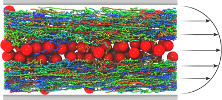 Complex liquids under flow are ubiquitous in nature and technology, ranging from the flow of blood in our bodies to the flow of surfactants in enhanced oil recovery. We are in particular interested in studying and designing microfluidic devices for sorting and separating colloidal particles based on their size and deformability. Such systems are especially important for biotechnological applications, for example protein purification, cell sorting, and early diagnosis of pathogenes. Complex liquids under flow are ubiquitous in nature and technology, ranging from the flow of blood in our bodies to the flow of surfactants in enhanced oil recovery. We are in particular interested in studying and designing microfluidic devices for sorting and separating colloidal particles based on their size and deformability. Such systems are especially important for biotechnological applications, for example protein purification, cell sorting, and early diagnosis of pathogenes.
However, little is known about the underlying physics of complex systems under flow, impeding the design and fabrication of effective devices. Computer simulations play a substantial role in advancing this field, as they allow for microscopic insights and precise control over the system parameters, which is otherwise often challenging or even impossible in experiments. For more information, please contact Arash Nikoubashman .
|